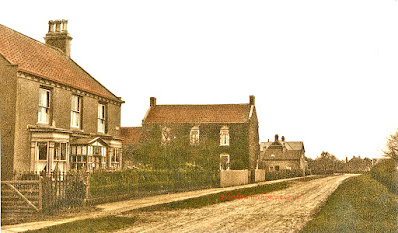As I write this it is frosty outside and the car windscreen is frozen.This is in contrast to the very warm weather we had over Christmas - which made it easy to keep the windows open when visitors came as we are still in the grip of Covid. I am hoping that when I read back over these blog posts in future months we shall remember this time but be socialising normally without taking tests before we go out.
I received some lovely Christmas presents and have plenty to read but the tree is now out and the decorations back in their boxes.
So now it is 2022 and as a family historian I am looking forward to exploring the 1921 census which has been released today on Find my Past. Only problem is that you cannot get a transcript or original image without paying, even if you have a subscription. But you can search for free and when I searched for my mother, Joan Nurse b 1918 in Eastrington I could see she was there and it told me that also on the page were Robert and Elsie, her parents. It correctly identified the Howden area where she was but said she was in Eastington in Gloucestershire. So a few teething problems!

|
| 80 years ago, January 1st 1942 Joan Nurse married Douglas Watson at Eastrington church. Soon after he was sent to serve in North Africa where he remained for three years. After his return my parents remained in Eastrington for the rest of their lives and taught many generations of children at Howden and Eastrington schools. |
After the popularity of the newspaper snippets in my last blog post here are a few more - this time from 1922
April 1922
For sale— Argyll (15 9) 2 seater car, sporting type JJ body, 1914 model, sleeve vale engine, CAV. lighting, Autovac petrol feed. Very smooth and silent; £250— J. Mortimer, The Gables, Eastrington.
For sale —Ford Car, 5-seater, 1920, fully licensed and insured; in splendid condition; £135. Any trial examination.—J Mortimer, The Gables, Eastrington.
 |
Station Road Eastrington from a colour postcard.
The Gables can just be seen in the background on the left. |
James Edward Mortimer was an entrepreneur born in Cleckheaton who built The Gables, then bought and moved to Knedlington manor and then finally to Howden hall where he died in 1946.July 1922 Hull Daily Mail
Hull market .There was a great glut of mushrooms today in the Shambles and shops, Mrs Lilley, of Eastrington, bringing in 1,000 lbs, which sold from 6d to ls per lb.
Aug 1922
HOWDEN. OBITUARY.—The remains of the late Arthur Britton, who for the past seven years had been proprietor of the Bowman's Hotel, were interred in the churchyard Saturday afternoon, the Rev A. Waring officiating. The chief mourners were:—Mrs Britton (widow), Mrs Angus, Mrs Oakes, Miss Gladys Britton, and Miss Kathleen Britton (daughters), Mr and Mrs Hargreaves (uncle and aunt), Mrs Wraight, Mr W. Ayland, Major, Mrs Cockroft and Mrs H. Cockroft. Floral tributes were sent by the widow and family, and Mrs Hargreaves, Mrs Wraight, and Mrs G. Moore, Mr and Mrs Blakey, Miss A. Newman, Miss N. Dealtry, Mr and Mrs J. Good, and Mrs B. Shaw, and the Howden Licensed Victuallers'Assoc. The deceased gentleman's dog followed the coffin to the Parish Church, and remained in tho building during the service, afterwards accompanying the funeral party to the graveside, where it stood and gazed down at the coffin.
Aug 1922
HOWDEN. OCTOGENARIAN'S DEATH:- The death of Mrs Jane Laughton has removed one of Howden's oldest residents. Deceased, who was the widow of the late Mr George Laughton, blacksmith, was 80 years of age, and was born in the same house in Flatgate in which she died. The funeral, which took place on Monday afternoon, was conducted by.the Rev Kellett (curate)
Nov 1922
A remarkable story of life-saving by telephone. While travelling from Selby to Howden on the L. and N.W. express on Saturday, two business men, Messrs Croft and Usher, looking out ot the window near Wressle, saw field alongside the line a bull, apparently its knees, attacking with its horns a young hoy, who was lying on the ground. I did not know whether to pull the communication cord or not," said Usher to a newspaper representative afterwards, but both Mr Croft and he instantly got out notebooks and scribbled notes follows "Bull killing boy in behind Wressle Station.' and threw these notes out as we passed level crossings. Arriving at Howden, Croft raced to the signal-box. The signalman quickly notified Wressle Station by 'phone, and the staff raced to the rescue. The child's life was saved, though he was badly mauled by the bull. He is the nine-year-old son of a farmer named Wood.




